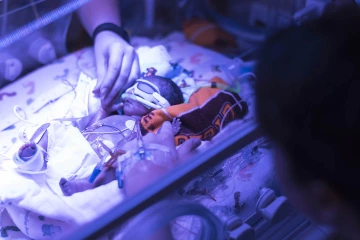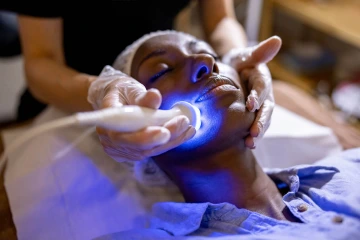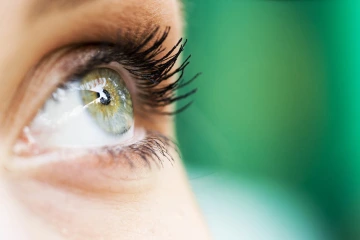Exploring phototherapy: a new option to manage chronic pain
Dr. Mohab Ibrahim defines light therapy and explains its potential benefits as a treatment for chronic pain.

Led by Dr. Mohab Ibrahim, researchers at the University of Arizona Health Sciences Comprehensive Center for Pain and Addiction are exploring potential benefits of using phototherapy to manage chronic pain.
At some point, everyone has experienced pain. Whether it is acute, from undergoing surgery, spraining your ankle or burning your tongue on a slice of pizza, or chronic due to conditions such as fibromyalgia or migraine, pain is unpleasant.

A baby born with bilirubin receives blue light therapy.
When pain occurs, most people seek relief from heat or ice packs, medications or alternative therapies, including massage, acupuncture or chiropractic care. At the University of Arizona Health Sciences, researchers are studying a new way to manage pain: phototherapy.
“How we report pain, how we experience pain, is always a personal experience. But why is there pain to begin with? Pain is a protective mechanism,” said pain management specialist Mohab Ibrahim, MD, PhD, medical director of the UArizona Health Sciences Comprehensive Center for Pain and Addiction and professor of anesthesiology at the UArizona College of Medicine – Tucson. “We need pain to survive, but on the other hand, let’s say someone has chronic knee pain from arthritis. That’s no longer a survival situation, that just an annoying situation. That’s when pain becomes pathological.”
Pain: An unpleasant sensory and emotional experience associated with, or resembling that associated with, actual or potential tissue damage.
– International Association for the Study of Pain
Dr. Ibrahim defines phototherapy as using different intensities and wavelengths, or brightness and colors, to alter or manipulate biological functions. During a Tomorrow is Here Lecture Series talk in Tucson, Arizona, he answered some questions about phototherapy and his research into green light therapy, which is breaking new ground in chronic pain management.
Q: There are a lot of medications and procedures to treat pain. Why do we need additional therapies?
Dr. Ibrahim: In pharmacology, we have many different families of medications to treat pain – nonsteroidal anti-inflammatory drugs such as ibuprofen, for example. But it comes with problems including gastric irritation, gastrointestinal bleed, kidney damage and increased risk for bleeding. People with chronic pain or neuropathic pain are probably familiar with the medication gabapentin, which can cause sedation, fatigue, memory impairment and increased weight. We can use tricyclic antidepressants such as amitriptyline or nortriptyline to clinically manage pain. They can cause fatigue, sedation, dry mouth, agitation, blurred vision or constipation. We also use anticonvulsants such as topiramate and carbamazepine, which can cause fatigue, dizziness, speech disorder or anxiety. Other classes of medications we use include opioids.

A dermatologist uses ultrasound and light therapy rejuvenation treatment on a woman’s face.
What we do as pain physicians is to try to decrease our reliance on medications, so we use procedures or different approaches to manage pain. Despite how great these medications and procedures are, they’re not always effective for some patients, they may be associated with some side effects, and they may be somewhat expensive. We need something complementary to decrease our reliance on these modalities, and that's where phototherapy comes into play.
Lights are not expensive, so it is an affordable treatment for most people. It is safer than many of the available therapies, but “safer” does not mean “safe.” For example, if you are using ultraviolet light, ultraviolet at a certain intensity and wavelength can cause DNA damage and cancer. Light is a medicine, and you must apply it correctly. Most importantly, phototherapy is a complementary treatment. We are not looking to replace something – phototherapy can be used in addition to our current treatments for chronic pain.
Q: Is phototherapy new?
Dr. Ibrahim: Phototherapy is already being used to treat various conditions. We know that phototherapy is used for seasonal affective disorder – that’s when people get depression because they haven’t seen the sun for long periods of time. One of the management tools for seasonal affective disorder is bright light therapy.
When I was a medical student doing my pediatric rotation, I was walking with some of my colleagues by the nursery and we saw these rows of babies with really cool shades under blue light. The physician teaching us told us the blue light was to break down bilirubin. Some babies, when they are born, develop a lot of bilirubin and they cannot get rid of it, so they become jaundice, or yellow. One of the treatments is to put them under blue light. The blue light is a treatment that acts through the skin. Similarly, dermatologists have been using different wavelengths of light to treat acne and other skin conditions.
Q: Does phototherapy only work through the skin?

Phototherapy through the skin usually takes place at the infrared red spectrum because red light is absorbed through the skin and penetrates deeper into the body.
Dr. Ibrahim: Phototherapy can exhibit its effects through the skin or the eyes. Phototherapy through the skin usually takes place at the infrared red spectrum, because it has deeper penetration. Researchers have found that it manipulates the cytokines, which are signaling proteins that help control inflammation in your body. Some cytokines cause pain; some cytokines decrease pain. When the skin was exposed to light, the concentration of cytokines that fight pain increased. I'm interested in how phototherapy works through the visual system.
Q: What have you learned about green light therapy?
Dr. Ibrahim: We ran two clinical trials where we enrolled two groups of patients – one with fibromyalgia and one with migraine. We exposed them to white light and then green light to see the effect. In both cases, white light, which we used as a control, really did not do much; however, when they were exposed to green light, pain in both cases decreased by about 50%. The frequency of migraine or fibromyalgia flare up decreased by 50%. Interestingly enough, their sleep also improved. Their quality of life improved. Their ability to function improved. Now, we don’t know if this is an independent factor or a consequence of their pain getting better or their sleep getting better. All we know, at this point, is that all these factors got better.
Also, the more exposure there was to green light, the more the effect we saw. For example, in the groups that we recruited for fibromyalgia and migraine, the protocol was one to two hours every night for 10 weeks. We saw that it took about three weeks on average for the participants to start feeling the beneficial effects of green light therapy. After that, the effect was additive, meaning week four was better than week three, week five was better than week four, week six was better than week five, and so on.

Dr. Ibrahim’s phototherapy research has found that green light therapy takes effect through the visual system.
This effect took place through the visual system. Since then, what we have been able to show is that green light decreased the inflammatory mediators and increased the anti-inflammatory mediators in the cerebrospinal fluid in the central nervous system – so the substances that cause pain decreased and the substances that cause a reduction in the sensation of pain increased. Most recently what we have shown is that green light exposure through the visual system decreased the activation of the microglia – the central nervous system’s immune cells – which means less secretion of the inflammatory mediators that are causing pain.
Q: What comes next?
Dr. Ibrahim: We will continue to understand how green light and phototherapy in general work. There are different trajectories for our lab. One is to understand the basic science behind phototherapy. What is happening in the brain? What cells are we modulating or influencing? Because if we know what phototherapy is doing, we will be able to manipulate the system and get more out of our therapy. Finding more indications to use phototherapy is another trajectory. The third trajectory is to make this more convenient for use clinically. Medicine is becoming what we call multimodal. It is no longer a one-person show. We need different specialists working together to manage a condition. So we are collaborating under the umbrella of the Comprehensive Center for Pain and Addiction to really advance medicine, not just tomorrow, we want to bring the entire future here today.
Our Experts
Mohab Ibrahim, MD, PhD
Professor of Anesthesiology
Associate Medical Director, Comprehensive Center for Pain and Addiction
Program Director, Pain Medicine Fellowship
Director, Chronic Pain Management Clinic
Professor, Pharmacology
Professor, Neurosurgery
Member, Clinical and Translational Oncology Program, UArizona Cancer Center
Contact
Stacy Pigott
Health Sciences Office of Communications
520-539-4152
spigott@arizona.edu

